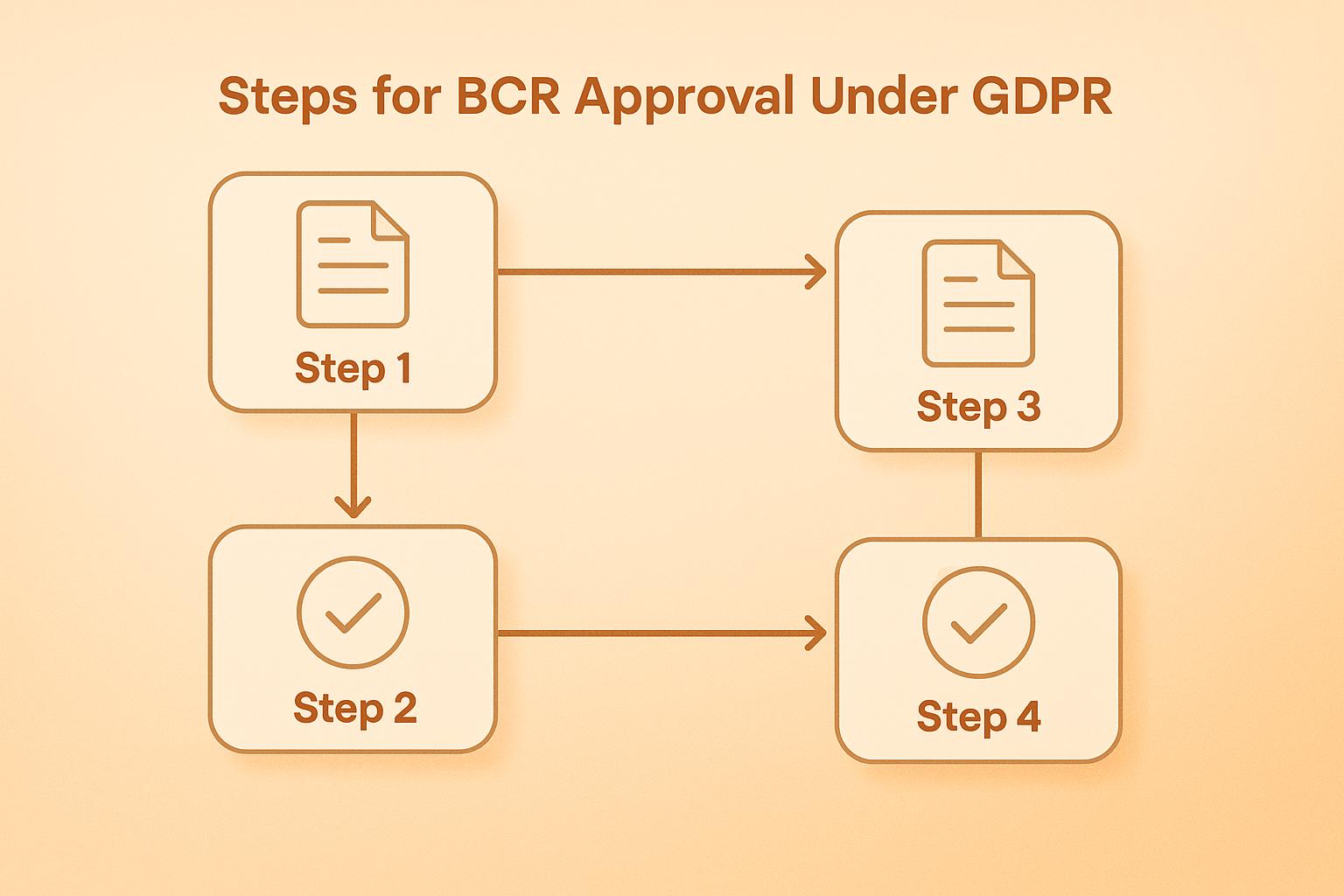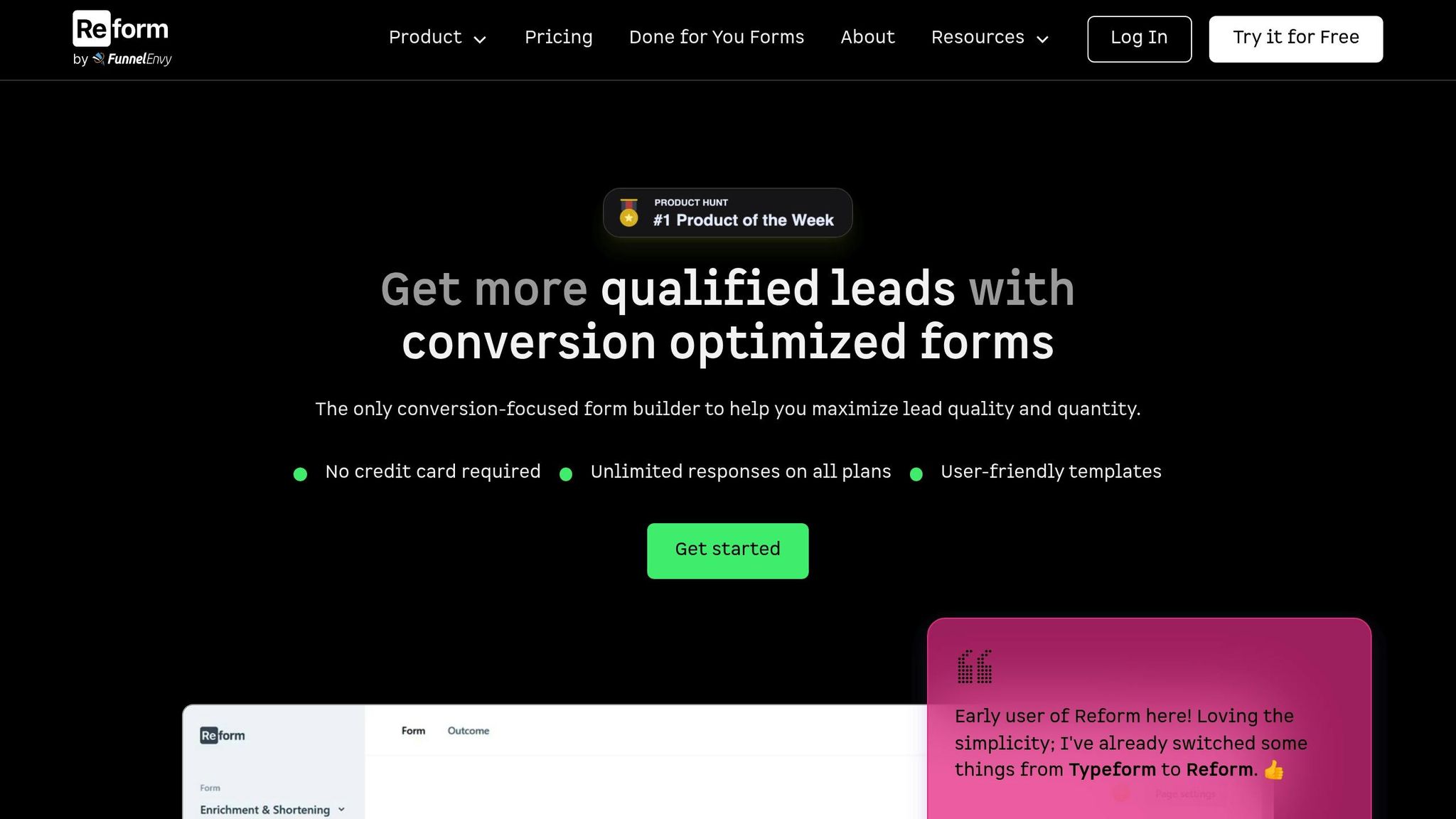Steps for BCR Approval Under GDPR

Want to transfer personal data across borders while staying GDPR-compliant? Binding Corporate Rules (BCRs) are your solution. They allow multinational companies to move data legally within their corporate group while maintaining consistent data protection standards.
Here’s a quick overview of the process:
- Prepare Your Organization - Map your corporate structure and data flows.
- Draft BCR Documents - Include data protection rules, security measures, and compliance frameworks.
- Work with Supervisory Authorities - Collaborate with your Lead Supervisory Authority (LSA) and follow their guidance.
- Approval Process - Authorities review your BCRs, often requiring updates before final approval.
- Post-Approval Steps - Train staff, update policies, and ensure ongoing compliance.
The entire process can take 18-24 months for first-time applicants, so detailed preparation and strong communication with authorities are key.
Read on for a step-by-step guide to simplify BCR approval and maintain GDPR compliance.
Get Data Protection Fit - Session 4: Binding Corporate Rules
What Are Binding Corporate Rules
Binding Corporate Rules (BCRs) are internal policies that allow multinational companies to legally transfer personal data within their corporate group. These rules ensure consistent data protection standards across all company branches, no matter where they are located.
BCR Basics and Functions
BCRs create a unified approach to managing data protection across a global organization. They serve several key purposes:
- Legal Framework - Require all group entities to follow specific data processing rules.
- Standardized Practices - Implement consistent privacy policies across the organization.
- Defined Responsibilities - Clearly assign data protection duties within the corporate group.
- Data Transfer Mechanism - Facilitate secure and lawful data transfers between company entities.
A strong BCR framework typically includes the following components:
| Component | Purpose |
|---|---|
| Data Processing Principles | Guidelines for collecting, processing, and storing personal data. |
| Security Measures | Technical and organizational steps to safeguard data. |
| Individual Rights | Processes for responding to data subject requests. |
| Breach Notification | Procedures for reporting and managing data breaches. |
| Training Requirements | Mandatory training programs for employees on data protection policies. |
GDPR Rules for BCRs
To comply with GDPR, BCRs must meet specific conditions to gain approval:
1. Legally Binding Nature
BCRs must be enforceable in every jurisdiction where the company operates. This includes adopting internal policies and external agreements that make these rules mandatory for all group members.
2. Comprehensive Coverage
The rules should address:
- Data processing principles
- Transparency obligations
- Practices to minimize data collection
- Policies for limiting data storage
- Security measures
- Procedures for respecting individual rights
3. Enforcement Mechanisms
BCRs must include:
- Procedures for handling complaints
- Protocols for working with supervisory authorities
- Regular auditing processes
- Appointed data protection officers
- Systems for reporting violations
This structure sets the foundation for the application process, which will be discussed next.
Before You Apply for BCRs
Company Structure and Data Flow Analysis
Before starting the application process for Binding Corporate Rules (BCRs), it's crucial to analyze your company's structure and how data flows within your organization. This step ensures your BCR documents accurately represent your data processing practices.
Start by creating a detailed map of your corporate group structure. Include the following:
| Element | Information |
|---|---|
| Group Entities | List all subsidiaries, branches, and affiliated companies |
| Geographic Presence | Countries where your entities operate and handle data |
| Processing Activities | Types of data processed by each entity |
| Transfer Routes | Data flow paths between group entities |
| Legal Relationships | Corporate structure and reporting lines |
Additionally, document these key details:
- Data Categories - Define the types of personal data being transferred between entities.
- Processing Purposes - Specify why each data transfer is necessary.
- Transfer Mechanisms - Outline the methods currently used for cross-border transfers.
- Security Measures - Note existing safeguards to protect data during transfers.
- Risk Assessment - Identify any vulnerabilities in your current data flow processes.
Writing BCR Documents
Once you've mapped your organization and data flows, the next step is writing your BCR documents. These documents need to comply with GDPR standards, so involve the right stakeholders from the start.
Here are the essential components to include:
| Component | Description | Required Elements |
|---|---|---|
| Data Protection Principles | Core privacy rules | Purpose limitation, data minimization, storage limits |
| Individual Rights | Subject access procedures | Request handling, response times, appeal process |
| Security Standards | Technical safeguards | Access controls, encryption, breach response |
| Training Requirements | Staff education | Training schedule, content outline, evaluation methods |
| Compliance Structure | Oversight framework | DPO roles, reporting lines, audit processes |
When drafting your BCR documents:
- Assemble a multidisciplinary team: Include legal experts, Data Protection Officers (DPOs), and IT security specialists.
-
Follow a structured review process:
- Legal team drafts the initial version.
- IT security reviews the technical aspects.
- Business units assess operational feasibility.
- Senior management provides final approval.
-
Align BCR policies with existing frameworks:
- Privacy policies
- Information security standards
- Employee handbooks
- Operational procedures
This approach ensures your BCR documents are precise, compliant, and ready for submission.
Working with Your Lead Authority
Regular Authority Communication
Clear and consistent communication with your Lead Supervisory Authority (LSA) is key to ensuring a smooth BCR approval process. Here are some practical tips to keep interactions on track:
| Communication Aspect | Best Practice | Frequency |
|---|---|---|
| Status Updates | Share progress reports regularly | Monthly |
| Document Submissions | Submit revisions promptly | As needed |
| Questions | Respond within 48 hours | Ongoing |
| Meetings | Arrange review sessions | Quarterly |
- Assign a dedicated point of contact to handle all LSA communication.
- Establish internal deadlines to ensure timely responses to authority requests.
- Keep strict version control for all submitted documents.
- Record all meetings and interactions for future reference.
- Create a follow-up system to address LSA feedback efficiently.
These steps help simplify and organize the BCR review process, minimizing potential delays.
sbb-itb-5f36581
Getting BCR Approval
Authority Review Process
The process for obtaining Binding Corporate Rules (BCR) approval starts with an initial assessment by the Lead Supervisory Authority (LSA), which typically takes 2-4 weeks. During this stage, the LSA evaluates your organization's compliance with GDPR Article 47, focusing on eligibility and preliminary drafts.
The assessment prioritizes these key compliance areas:
| Compliance Area | Key Requirements | Authority Focus |
|---|---|---|
| Accountability | Audit procedures, training programs | Quality of documentation |
| Data Rights | Subject access protocols | Response timelines |
| Processor Controls | Third-party oversight | Contract provisions |
| Enforcement | Cross-border mechanisms | Incident handling |
After this initial review, the authorities collaborate to refine and improve your submission.
EU Authority Cooperation
Once the initial assessment is complete, the EU authorities move into a coordinated evaluation phase. This phase typically involves 1-2 co-reviewing authorities who review the updated drafts.
"The Lead Authority must resolve conflicting feedback through structured sessions with Supervisory Authority representatives to reach consensus on contentious issues", states the European Data Protection Board (EDPB) in its 2024 guidance.
During the cooperation phase, all involved authorities have one month to provide feedback. If no response is given within this timeframe, it is treated as consent.
BCR Approval Steps
After completing the review stages, the final approval process begins. The EDPB opinion phase usually takes 8-14 weeks. In 2024, 93% of BCR applications required modifications based on EDPB recommendations before receiving final approval.
Key factors for success include:
- Building a strong relationship with the Lead Authority
- Using standardized EDPB templates
- Conducting thorough pre-submission audits
Once approved, organizations must meet specific post-approval requirements:
- Publish BCRs internally within 30 days
- Complete mandatory training within 60 days
- Submit the first annual compliance report within 12 months
For first-time applicants, the entire approval process generally takes 18-24 months. Updates to existing BCRs are quicker, requiring 6-9 months. These timelines emphasize the importance of detailed preparation and adherence to the necessary frameworks and documentation.
After BCR Approval
Staff Training on BCRs
Once your Binding Corporate Rules (BCRs) are approved, kick off staff training right away. Make sure employees understand the core principles of the BCRs and how these apply to their specific roles. Tailored training ensures everyone knows their responsibilities under GDPR and strengthens your organization's commitment to data protection. Regular refresher sessions can also help keep compliance top of mind.
Regular BCR Updates
Keeping your BCRs up to date is crucial. Schedule periodic reviews to address any changes in data processing activities, regulatory requirements, or your company's structure. Always document these updates and inform supervisory authorities to ensure your BCR framework stays aligned with current standards.
Managing BCRs with Reform

After approval, keeping track of and ensuring compliance with Binding Corporate Rules (BCRs) is essential. Reform simplifies this process by offering tools for both documentation and monitoring.
BCR Forms with Reform
Reform's multi-step forms make documenting BCRs straightforward. These custom forms collect key data from all relevant entities. With conditional routing, submissions are automatically sent to the right stakeholders, while lead enrichment pre-fills fields using existing company data. This reduces repetitive data entry across subsidiaries. Features like email validation and spam prevention ensure submissions are legitimate and come from verified sources.
Once all the necessary documentation is gathered, Reform's built-in tools help you track progress without hassle.
BCR Progress Tracking
Reform’s real-time dashboard gives you a clear view of BCR approval progress. It shows form completion rates and flags any bottlenecks. By connecting with your existing CRM systems and internal tools through webhooks and APIs, Reform ensures automatic updates on approval statuses and deadlines. The platform also tracks abandoned submissions, helping you identify where entities might face challenges with completing documentation.
For companies handling multiple BCR applications, Reform provides a structured way to monitor progress:
| Progress Stage | Tracking Features | Benefits |
|---|---|---|
| Documentation Collection | Multi-step forms with save progress | Lets entities complete forms over time |
| Authority Review | Real-time status tracking | Offers instant visibility into approvals |
| Managing Feedback | Response routing | Ensures feedback reaches the right teams |
| Compliance Updates | Webhook notifications | Keeps everyone informed about key changes |
"I'm a happy customer. One of the best parts of being a customer is that they constantly send emails with new additions to the software. And each addition is based on real customer requests." - Andrew Warner, Founder, Mixergy
Conclusion
Getting BCR approval under GDPR requires careful planning. Start with solid preparation and detailed documentation, and work closely with your lead authority to keep things moving smoothly through regular communication and timely feedback.
After completing your documentation, collaboration with your lead authority becomes essential. The cooperation phase with EU authorities, though complex, ensures your BCRs meet consistent standards across all jurisdictions.
Once approved, BCRs aren't a "set it and forget it" solution. Maintaining compliance means ongoing efforts like:
- Regular updates to align with organizational changes
- Training programs to keep staff informed
- Monitoring compliance continuously
- Keeping thorough records of data protection practices
Tools like Reform, mentioned earlier, simplify both the application process and ongoing management. Its form-building and progress tracking features help reduce the workload while keeping your organization compliant.
"I'm a happy customer. One of the best parts of being a customer is that they constantly send emails with new additions to the software. And each addition is based on real customer requests." - Andrew Warner, Founder, Mixergy
To make BCRs work long-term, treat them as a living framework that evolves with your organization's needs. With strong documentation and proactive updates, your BCRs will remain a reliable solution for international data transfers under GDPR.
FAQs
What steps should multinational companies follow to ensure their Binding Corporate Rules (BCRs) comply with GDPR requirements across different jurisdictions?
To ensure Binding Corporate Rules (BCRs) comply with GDPR across various jurisdictions, multinational companies should follow these key steps:
- Prepare a comprehensive BCR application - Include details about data transfers, security measures, and compliance processes. Ensure the application aligns with GDPR requirements and addresses the specific needs of all jurisdictions involved.
- Submit the application to a lead supervisory authority - Choose a supervisory authority in the EU that will act as the primary point of contact during the approval process. This authority will coordinate with others as needed.
- Undergo a thorough review process - The lead authority will assess the BCRs for compliance with GDPR. This may involve feedback or recommendations for adjustments to meet regulatory standards.
- Obtain final authorization - Once the review is complete and all concerns are addressed, the lead authority, in collaboration with other relevant authorities, will issue final approval for the BCRs.
It’s essential to maintain clear documentation and ensure regular updates to the BCRs as regulations or company practices evolve. This proactive approach helps demonstrate ongoing compliance and builds trust with both regulators and stakeholders.
What challenges do companies often face during the BCR approval process under GDPR, and how can they overcome them?
The Binding Corporate Rules (BCR) approval process under GDPR can be complex and time-consuming. Companies often face challenges such as:
- Ensuring comprehensive documentation - Organizations must provide detailed information about their data protection policies, practices, and safeguards, which can be resource-intensive.
- Navigating regulatory requirements - Different Data Protection Authorities (DPAs) may have varying expectations, making it crucial to align with their specific guidelines.
- Lengthy review timelines - The approval process involves multiple stages, including submission, review, and final authorization, which can take months or even years to complete.
To address these challenges, companies should invest in thorough preparation, including consulting legal experts, standardizing internal processes, and maintaining open communication with DPAs. This proactive approach can help streamline the process and improve the chances of timely approval.
What are a company’s ongoing responsibilities to stay compliant with GDPR after receiving BCR approval?
After receiving Binding Corporate Rules (BCR) approval, companies must actively maintain compliance with GDPR by fulfilling several key responsibilities:
- Regular audits and updates - Conduct periodic reviews of BCR policies to ensure they align with any changes in business operations or GDPR requirements.
- Employee training - Continuously train employees on data protection practices and the specific requirements of the BCR.
- Monitoring and reporting - Establish processes to monitor compliance and promptly report any data breaches or non-compliance issues to the relevant supervisory authority.
Staying compliant is an ongoing effort that requires commitment to transparency, accountability, and maintaining robust data protection practices across all corporate entities.
Related posts
Get new content delivered straight to your inbox

The Response
Updates on the Reform platform, insights on optimizing conversion rates, and tips to craft forms that convert.
Drive real results with form optimizations
Tested across hundreds of experiments, our strategies deliver a 215% lift in qualified leads for B2B and SaaS companies.





